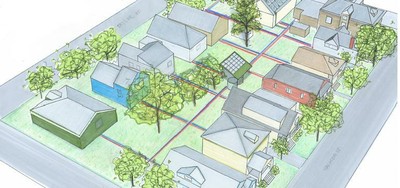 A recent report completed by the Center for Social Inclusion (CSI) called “Energy Democracy: Community-Scale Green Energy Solutions” highlights a critical fact about energy access and neighborhood-scale clean energy infrastructure. We’ve highlighted before the disparity between what more affluent families pay for energy and what poorer families pay. But CSI goes just a bit further in looking at barriers and opportunities for whole neighborhoods of lower income people to become more energy efficient and independent.
A recent report completed by the Center for Social Inclusion (CSI) called “Energy Democracy: Community-Scale Green Energy Solutions” highlights a critical fact about energy access and neighborhood-scale clean energy infrastructure. We’ve highlighted before the disparity between what more affluent families pay for energy and what poorer families pay. But CSI goes just a bit further in looking at barriers and opportunities for whole neighborhoods of lower income people to become more energy efficient and independent.
Poorer households, which are disproportionately families of color, used 385 billion kilowatt hours of electricity in 2009, which is about $41 billion worth of energy. The study poses an important question: these households are big consumers of energy but “could they be significant producers, too?“
The answer is ‘yes,’ provided that energy efficiency advocates, utilities, and government agencies begin paying more attention to the potential.
The goal of Energy Democracy is to create community-owned or controlled renewable energy and invest that capacity with democratic principles that foster interdependence, conservation, wealth-building, political autonomy, and economic opportunities in this demographic.
In order to begin to tap into this potential, the report recommends:
- Make community renewable energy policy a federal priority by putting more resources into pilot and demonstration projects that can attract additional private investment.
- Support Feed-in-Tariffs (FiT), which require that utilities purchase electricity from renewable electricity system owners at long-term, fixed rates established by utilities and/or regulatory commissions.
- Create legal structures to facilitate community energy production, not unlike the concept of Green Energy Investment Trusts and neighborhood owned energy utilities.
- Prioritize community renewable energy policy in land use. Land use and energy are not often talked about in the same sentence. But district energy projects often require use of right of way. And if neighborhood-focused projects are to work, there must be changes to allow energy production in residential neighborhoods. Portland is the first city in the Northwest to have started these kinds of revisions.
The concept of Energy Democracy takes the concept of Retrofits for All one step further. Energy Democracy proposes that neighborhoods of poorer people get not only the benefits of energy efficiency retrofits, but also the ability to produce their own energy. District energy proposals like Sunnyside Energy and the North Portland District Energy proposal are examples of taking the initiative for clean energy to a radically local level. And the technology and feasibility of district energy are well tested. Renewable projects like the one I wrote about in Grays Harbor, Washington use a different technology, but they are also locally-scaled, generating revenue for much-needed social and health services.
Sightline has been very involved lately in discussions in Oregon and Washington about how to use Qualified Energy Efficiency Bonds (QECBs) to pilot neighborhood-scale district energy projects. The devil is in the details, of course. But the principle is simple: use public money to invest in clean energy and energy independence. Neighborhood-scale energy can create jobs and save money; and it can generate a revenue stream that can pay back the money borrowed by a city to build a project. Perhaps the best part is that community-scaled projects can enfranchise people often left out of the clean energy dream.
Image: Schematic of n2e’s Salmon Street Energy proposal.







